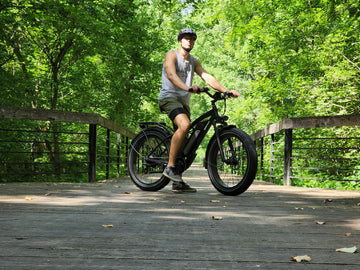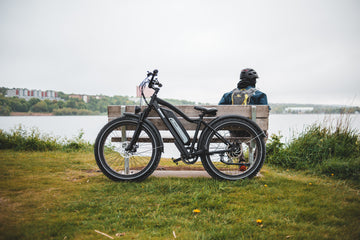In recent years, the soaring popularity of e-bikes has reshaped the way people commute and explore their surroundings. These electric-powered bicycles offer a versatile and eco-friendly mode of transportation, attracting a diverse range of enthusiasts – from urban commuters seeking convenience to adventure seekers craving off-road thrills. However, amid this e-bike revolution, ensuring rider safety and accident prevention has taken center stage as a paramount concern.
E-bikes have transcended traditional cycling norms, providing riders with the ability to cover distances effortlessly and navigate diverse terrains with ease. This unique combination of functionality and fun has contributed to their widespread adoption. As e-bikes become an integral part of modern mobility, it becomes imperative to prioritize safety measures that keep riders secure during their journeys.
The significance of safety and accident prevention cannot be overstated. While e-bikes offer numerous benefits, they also come with unique risks that necessitate attention. From collisions with vehicles and road hazards to the need for proper rider training, understanding and mitigating these potential dangers are pivotal in fostering a safe e-bike ecosystem. This article delves into these critical aspects, shedding light on both the surging popularity of e-bikes and the imperative of embracing safety measures to ensure enjoyable, secure rides for all.

Understanding E-bike Accidents
Common Causes of E-bike Accidents
The burgeoning popularity of e-bikes has brought about a transformative shift in transportation, but alongside this revolution comes a pressing need to comprehend the common causes of e-bike accidents. These accidents can stem from a range of factors, each presenting unique challenges that demand attention and preventive measures.
Collision with Vehicles: One of the most prominent risk factors for e-bike riders is collisions with vehicles. The coexistence of e-bikes and traditional vehicles on roadways can be fraught with challenges. The speed differential between e-bikes and motorized vehicles, coupled with potential visibility issues, makes intersections and lane changes particularly hazardous. These accidents are often exacerbated by drivers failing to anticipate the speed and maneuverability of e-bikes.Road Hazards and Obstacles: E-bike riders are not immune to the perils of uneven road surfaces, potholes, and unexpected obstacles. The higher speeds achievable with e-bikes can magnify the consequences of hitting road hazards, leading to loss of control and accidents. Navigating urban landscapes and natural terrains alike requires vigilant attention to the road ahead to avoid these potential pitfalls.
Lack of Experience or Training: The accessibility of e-bikes has attracted a wide range of riders, including those with limited cycling experience. Inadequate training and unfamiliarity with e-bike dynamics can lead to accidents. Maneuvering an e-bike, particularly in traffic or challenging terrains, demands a degree of skill and understanding that novice riders may lack. This underscores the importance of education and training for all e-bike enthusiasts.
Acknowledging these common causes of e-bike accidents is the first step toward proactively addressing safety concerns. A comprehensive approach involving rider education, vehicle-driver awareness, and the integration of safety-enhancing technologies in e-bike design can collectively work to mitigate these risks. By embracing a culture of safety, riders and stakeholders can pave the way for safer, more enjoyable e-bike journeys.
Statistics Underscoring the Significance of E-bike Accidents
The proliferation of e-bikes has undeniably brought convenience and excitement to modern transportation, but the surge in e-bike accidents and injuries demands our attention.
The Rise in E-bike Accidents and Injuries With the exponential growth in e-bike usage, the incidence of accidents has witnessed a corresponding increase. The allure of higher speeds and extended ranges, facilitated by electric assistance, has resulted in a greater likelihood of accidents. Data reveals a concerning uptick in accidents involving e-bikes, necessitating a proactive approach to enhance safety measures.Comparisons with Traditional Bicycle Accidents Comparative analyses between e-bike accidents and traditional bicycle accidents further highlight the distinctive risks posed by e-bikes. While both share vulnerabilities on the road, e-bikes often exhibit higher speeds and, in some cases, greater weight due to their electric components. This unique combination can lead to accidents with different dynamics and potentially more severe outcomes. Recognizing these distinctions is crucial in crafting targeted safety protocols that address the specific challenges of e-bike riding.
To mitigate these escalating risks, it is paramount to prioritize safety education, stringent regulations, and advanced safety features in e-bike design. Manufacturers like Himiway Bikes are leading the charge by integrating safety-focused features into their products and emphasizing rider education. By acknowledging the statistics and understanding the disparities between e-bike and traditional bicycle accidents, we can collectively work toward a safer riding environment for everyone.

The Role of Himiway Bikes in Promoting Safety
Unveiling Himiway Bikes and Their Safety-Focused Features
Diverse Product Range: Himiway Bikes boasts an impressive array of e-bike models tailored to various preferences and terrains. From the urban streets to rugged trails, Himiway has a solution for every rider.
Safety-First Design Philosophy: Safety is woven into the very fabric of Himiway's e-bikes. Each model is infused with features intended to enhance rider security and minimize accident risks.Engineered for Safety: Prioritizing Rider Security through Design
Robust Construction and Durability: Himiway e-bikes are engineered to withstand diverse conditions. Their sturdy frames and durable components are designed to minimize damage in case of accidents.
Safety Guidelines for E-bike Riders
Preparation Before Every Ride
Embrace Proper Helmet Usage and Safety Gear: Wearing a helmet and appropriate safety gear significantly reduces the risk of head injuries in case of accidents. Himiway emphasizes the importance of these protective measures.
Thorough E-bike Inspection: Prior to embarking on any ride, riders should meticulously inspect their e-bikes for any signs of wear, loose components, or mechanical issues. Regular maintenance can prevent accidents caused by equipment failure.Mastering the Rules of the Road
Familiarity with Traffic Laws: Abiding by traffic laws is paramount. Himiway encourages riders to understand and adhere to local regulations, ensuring a harmonious coexistence with other road users.
Adopt Defensive Riding Techniques: Defensive riding involves staying alert, predicting potential hazards, and maintaining visibility. These techniques can avert accidents caused by unexpected actions from pedestrians, cyclists, or drivers.Navigating Potential Hazards
Identifying Road Obstacles: E-bike riders should develop a keen eye for road hazards like potholes, debris, and uneven surfaces. This skill is pivotal in avoiding accidents resulting from sudden destabilization.
Weather Preparedness: Weather conditions can drastically impact road safety. Himiway advises riders to adjust their riding style and speed in adverse weather, reducing the chances of accidents due to reduced traction.Maintenance and Care of Himiway E-bikes
Regular Maintenance Checks: Himiway recommends routine maintenance checks to ensure that all components are functioning optimally. Addressing minor issues promptly can prevent them from escalating into safety hazards.
Battery Maintenance: E-bike batteries are the lifeblood of the vehicle. Keeping them charged and well-maintained is essential for preventing unexpected power failures while riding.In the fast-paced landscape of modern transportation, e-bikes have emerged as a game-changer, offering convenience and efficiency. However, the imperative of safety in preventing e-bike accidents cannot be overstated.
E-bike popularity continues to surge, ensuring rider safety becomes a moral and practical obligation. The unique dynamics of e-bikes, including higher speeds and varying terrains, demand a heightened focus on safety measures. From educating riders about road rules and defensive techniques to equipping them with the right protective gear, fostering a safety-conscious culture is paramount to preventing accidents.
Himiway Bikes stands as a beacon of commitment to rider safety in the e-bike industry. Through their innovative designs and emphasis on safety features, they've elevated the standard for secure e-bike riding. By intertwining durable construction, powerful motors, and educational resources, Himiway empowers riders to embark on their journeys with confidence.
In conclusion, the flourishing realm of e-bikes has ushered in a transformative era of transportation, yet it's crucial to remember that safety remains the linchpin. By recognizing the challenges specific to e-bikes, individuals and manufacturers alike can collaboratively contribute to safer roads. Himiway Bikes' unwavering dedication to rider safety serves as an inspiring model for the industry, forging a path towards accident prevention and secure, enjoyable e-bike experiences for all.


















